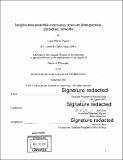Insights into microbial community structure from pairwise interaction networks
Author(s)
Higgins, Logan Massie.
Download1019900799-MIT.pdf (9.772Mb)
Other Contributors
Massachusetts Institute of Technology. Department of Biology.
Advisor
Jeff Gore.
Terms of use
Metadata
Show full item recordAbstract
Microbial communities are typically incredibly diverse, with many species contributing to the overall function of the community. The structure of these communities is the result of many complex biotic and abiotic factors. In this thesis, my colleagues and I employ a bottom-up approach to investigate the role of interspecies interactions in determining the structure of multispecies communities. First, we investigate the network of pairwise competitive interactions in a model community consisting of 20 strains of naturally co-occurring soil bacteria. The resulting interaction network is strongly hierarchical and lacks significant non-transitive motifs, a result that is robust across multiple environments. Multispecies competitions resulted in extinction of all but the most highly competitive strains, indicating that higher order interactions do not play a major role in structuring this community. Given the lack of non-transitivity and higher order interactions in vitro, we conclude that other factors such as temporal or spatial heterogeneity must be at play in determining the ability of these strains to coexist in nature. Next, we propose a simple, qualitative assembly rule that predicts community structure from the outcomes of competitions between small sets of species, and experimentally assess its predictive power using synthetic microbial communities composed of up to eight soil bacterial species. Nearly all competitions resulted in a unique, stable community, whose composition was independent of the initial species fractions. Survival in three-species competitions was predicted by the pairwise outcomes with an accuracy of ~90%. Obtaining a similar level of accuracy in competitions between sets of seven or all eight species required incorporating additional information regarding the outcomes of the three-species competitions. These results demonstrate experimentally the ability of a simple bottom-up approach to predict the structure of communities and illuminate the factors that determine their composition.
Description
Thesis: Ph. D., Massachusetts Institute of Technology, Department of Biology, 2017 Cataloged from PDF version of thesis. Includes bibliographical references.
Date issued
2017Department
Massachusetts Institute of Technology. Department of BiologyPublisher
Massachusetts Institute of Technology
Keywords
Biology.